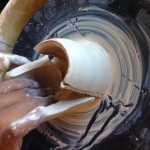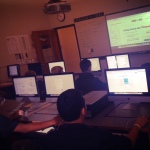 “Wet clay high five!” I exclaimed to Robert, as he sliced his cylinder in half. Smiling, he gave me a satisfying ‘splat,’ palm-to-palm.
“Wet clay high five!” I exclaimed to Robert, as he sliced his cylinder in half. Smiling, he gave me a satisfying ‘splat,’ palm-to-palm.
We had just shared the observation that the pot he was trying to throw had no bottom. This happens often, early in throwing; just a bit too far with the thumbs, and you’ve made either a flower pot or a telescope. For the purposes of this first assignment on the wheel, we have defined a cylinder as straight walls, taller than wide, and having a base.
So – no bottom, no pot.
However, although we are trying to create five wheel-thrown cylinders this week, Robert’s pot was by no means a loss. You can learn a lot by looking at the walls of a sliced cylinder. “Check it out,” I said, as he showed me the slice. “You’ve got a great even taper here, no thin spots or twitches. All you’ve got to do is lift a little more, so it’s not quite so thick.”“And leave a bottom,” he adds, smiling, and heads to the pug.
We fail together every day in a ceramics class – fluently, with few regrets, occasional saves, and frequent laughs. Indeed, I think my students know that they have to fail in order to succeed. If you don’t take risks, if you don’t push past what you’re capable of doing (which, for my Ceramics I students, is not much at first), you don’t learn the process.
A pug mill is our saving grace. If a pot flops, pug it, try it again. One of the greatest blessings of clay is that the stuff is reusable, recyclable, uncommitted until its first firing. The bisque firing changes it into a substance that will be in the world for six thousand years, whether you like it or not. But prior to that first firing, the failures aren’t really failures, exactly; they are steps of the process.
When I assess in a level one ceramics class, I plan things so that sketchbook assignments, class participation, and other coursework balance out the scores of a potential ‘failure’ on a project. Basically – your pot could fall over, or blow up in the kiln, and you can still do alright in the class, as long as you keep on top of the non-clay work and participate. Product is emphasised a little more in level two, and even more in three, four, and beyond. But by the time a student might opt to take an advanced-level class, we have hopefully built enough of a trust relationship that he feels safe to take process and product risks. I expect him to have a solid basic skillset (i.e. being able to throw those cylinders) – but when he wants to push beyond (i.e. throw a 48” tall cylinder) I’m going to fully support him, even if product might represent a challenge (darn, it toppled at 36”… so what did we learn?).
Here’s the challenge, though. These failure opportunities are not real world. The only person who is affected by a flopped or bottomless cylinder is my student who flopped it. Or – stretching it – maybe the audience (friends, family) who might not get to appreciate his finished work. My friend Jon likes to say, “There are more than enough bad pots in the world,” which I take as a reminder that I shouldn’t fire most of the things I make. But, hey, what’s the world without a few more bad or good pots? It’s not really failure. It’s just fodder for the pug mill.
“[Dominic] Randolph [head of Riverdale Country School] was worried… that his mostly affluent students, caught up in the modern American meritocratic machine of private schools, private tutors, Ivy League colleges, and safe careers, were being shortchanged by their families and their school and even their culture by not being given enough genuine opportunities to overcome adversity and thus develop their character. ‘The idea of building grit and building self-control is that you get that through failure,’ Randolph told me. ‘And in most highly academic environments in the United States, no one fails anything.”
Paul Tough, How Children Succeed
 I ran into a more authentic problem in my Graphic Design class this week. I’m lucky to have a small group of upper-level students this year, and I asked them to hit the ground running with immediate real-world projects – logos and branding for a few upcoming events, on a deadline. These are projects for which I would ordinarily be accountable. It would be easier for me to just do them – but instead, I thought it might be motivating for my students to have the potential of real-world work in their portfolios.
I ran into a more authentic problem in my Graphic Design class this week. I’m lucky to have a small group of upper-level students this year, and I asked them to hit the ground running with immediate real-world projects – logos and branding for a few upcoming events, on a deadline. These are projects for which I would ordinarily be accountable. It would be easier for me to just do them – but instead, I thought it might be motivating for my students to have the potential of real-world work in their portfolios.
I tried really hard to light the fire, to coach them individually, to impress on the deadlines, and to keep the creative tension strong. But when we ran into the deadline, none of the student projects were complete. And because the work was real, with real consequences in marketing the events if it wasn’t finished, I had to fill in the blanks. It was seven o’clock last night, and I was still staring at my 13” screen, trying to adjust these logos to a colleague’s specs. By eight, I had it done – but piles more of my teaching work awaited.
I tried to analyze why I was so tense about it all, and here it is: I wanted my students to experience the authenticity of failure. They should have been the ones working late, consulting the client, adjusting to specs. Instead, I taught them the wrong lesson: someone else will pick up the pieces and make sure that things work out. I missed something. And I’m not sure where to pick this ‘something’ up.Doing all of my homework no longer felt realistic. My friends and I realized we didn’t have to do everything assigned to us in order to succeed in high school. We found shortcuts and we minimized our efforts in order to get the grades we wanted. The middle school “memorization not rationalization” mindset that Karl Taro Greenfield describes in his recent Atlantic essay turns into a more insidious “How can I do as little as possible and still get an A?” mentality.
Elif Koc, My Insane Homework Load Taught Me How to Game the System, The Atlantic
Letter grades mean nothing in this context. I might give them a lower score for their work on this project, but there will be other ways they can make up their score. The tension in my neck and back today doesn’t come from letter grading. It comes from a desire for them to understand what it means to care about your work, what it means to be accountable, what it means to push past the assignment and meet the real-world challenge.
It seems I have an authenticity problem in both subjects that I teach. It’s a challenge, maybe a self-imposed one. After all, education is practice-life, and I probably shouldn’t expect too much authentic work from my students, right? But I’m haunted by the closing quote in that Atlantic essay I cited above (written by a college freshman), when I wonder what it is, exactly, that I’m teaching them.“Maybe the objective of high school is to become a good student. I hope college is where I can become a good learner.”
What can I do to help the learners in my classes see their work as authentic and substantial, beyond the assignment and beyond the walls of a classroom?







You could start by sharing this post with them. It may be unorthodox, but then again most truly authentic acts are…I feel for you and I think you seem like a wonderful teacher. Share these insights, concerns and questions with them. You can even ask them how to help them shift their focus from “students” to “learners.” You never know what they might surprise you with…
Kate, I love what “kaycers” says in her comments…but I am sure you’re already there.
I’d love to know what ended up happening!?
Thanks, both of you. I *did* share the post with my students. It’s a small class, hybrid/independent study, and the post MAY have boosted them a bit, but I’m not sure. It’s perpetually frustrating to have to shield them from risk/failure, when outcomes have real-world consequences.
I think being perpetually frustrated is the mark of an excellent teacher 😉